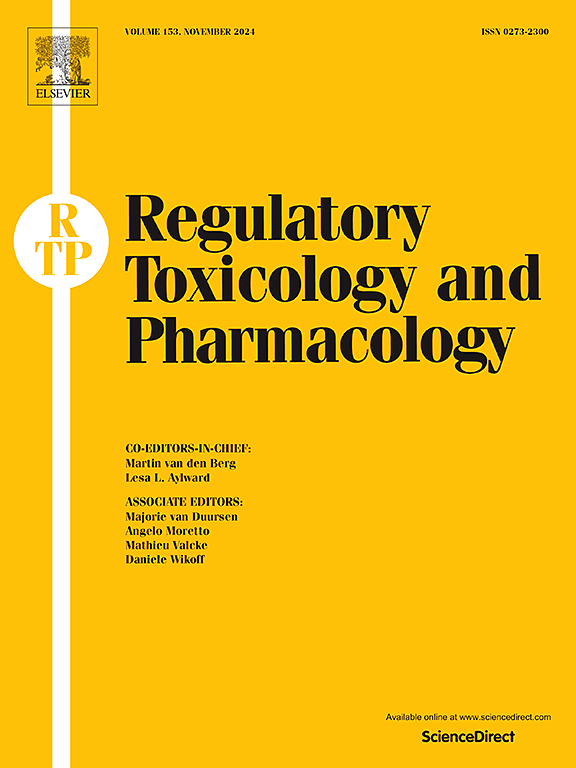评估作为亚硝胺致癌性基础的终生累积剂量——建立可接受摄入量限制的非终生方法的关键原则。
IF 3.5
4区 医学
Q1 MEDICINE, LEGAL
引用次数: 0
摘要
与药物中n -亚硝胺(NAs)杂质相关的潜在健康风险已受到广泛关注。监管指南建议建立可接受的摄入量限制(AIs),以保护日常暴露。然而,问题仍然是相同的限制是否适用于使用寿命(LTL)以下的药品中的NA杂质。ICH M7(R2)指南通过为LTL暴露建立更高的AIs来解决致突变杂质的这一问题;然而,目前的监管指南并未采用这一方法,因为NA杂质属于关注队列(潜在的高致癌物)。本文描述的研究解决了一个关键的知识空白:NAs的致癌效力是总暴露而不是剂量率的函数,这是ICH M7(R2) LTL方法的基本原则。对8种NAs和黄曲霉毒素B1(另一种高效致癌物)的啮齿动物致癌性生物测定数据进行了评估,暴露时间为21至120周。在所有案例研究中,发现致癌效力是总累积剂量的函数,而不是日剂量的函数,这与ICH M7(R2)指南一致,该指南认为,对于LTL持续时间,更高的AI限制是合理的。其余的知识差距将在随后的出版物中加以解决。本文章由计算机程序翻译,如有差异,请以英文原文为准。
Evaluating the lifetime cumulative dose as a basis for carcinogenic potency of nitrosamines – a key tenet underpinning less-than-lifetime approaches for establishing acceptable intake limits
Potential health risks associated with N-nitrosamine (NAs) impurities in pharmaceuticals have received significant attention. Regulatory guidance recommends methods to establish Acceptable Intake limits (AIs) that are protective for daily lifetime exposure. However, questions remain whether the same limit should apply to NA impurities in drug products used for less than lifetime (LTL). The ICH M7(R2) guidance addresses this for mutagenic impurities by establishing higher AIs for LTL exposures; however, this has not been adopted in current regulatory guidance for NA impurities which fall under the Cohort of Concern (potentially high potency carcinogens). The research described herein addresses one key knowledge gap: that carcinogenic potency of NAs is a function of total exposure rather than dose rate, a fundamental principle underlying the ICH M7(R2) approach for LTL. Data were evaluated from rodent carcinogenicity bioassays for eight NAs and aflatoxin B1 (another high potency carcinogen) involving exposure durations from 21 to 120 weeks. For all case studies, carcinogenic potency was found to be a function of total cumulative dose rather than daily dose, aligning with the ICH M7(R2) guidance, which posits that higher AI limits can be justified for LTL durations. Remaining knowledge gaps will be addressed in a subsequent publication.
求助全文
通过发布文献求助,成功后即可免费获取论文全文。
去求助
来源期刊
CiteScore
6.70
自引率
8.80%
发文量
147
审稿时长
58 days
期刊介绍:
Regulatory Toxicology and Pharmacology publishes peer reviewed articles that involve the generation, evaluation, and interpretation of experimental animal and human data that are of direct importance and relevance for regulatory authorities with respect to toxicological and pharmacological regulations in society. All peer-reviewed articles that are published should be devoted to improve the protection of human health and environment. Reviews and discussions are welcomed that address legal and/or regulatory decisions with respect to risk assessment and management of toxicological and pharmacological compounds on a scientific basis. It addresses an international readership of scientists, risk assessors and managers, and other professionals active in the field of human and environmental health.
Types of peer-reviewed articles published:
-Original research articles of relevance for regulatory aspects covering aspects including, but not limited to:
1.Factors influencing human sensitivity
2.Exposure science related to risk assessment
3.Alternative toxicological test methods
4.Frameworks for evaluation and integration of data in regulatory evaluations
5.Harmonization across regulatory agencies
6.Read-across methods and evaluations
-Contemporary Reviews on policy related Research issues
-Letters to the Editor
-Guest Editorials (by Invitation)

 求助内容:
求助内容: 应助结果提醒方式:
应助结果提醒方式:


